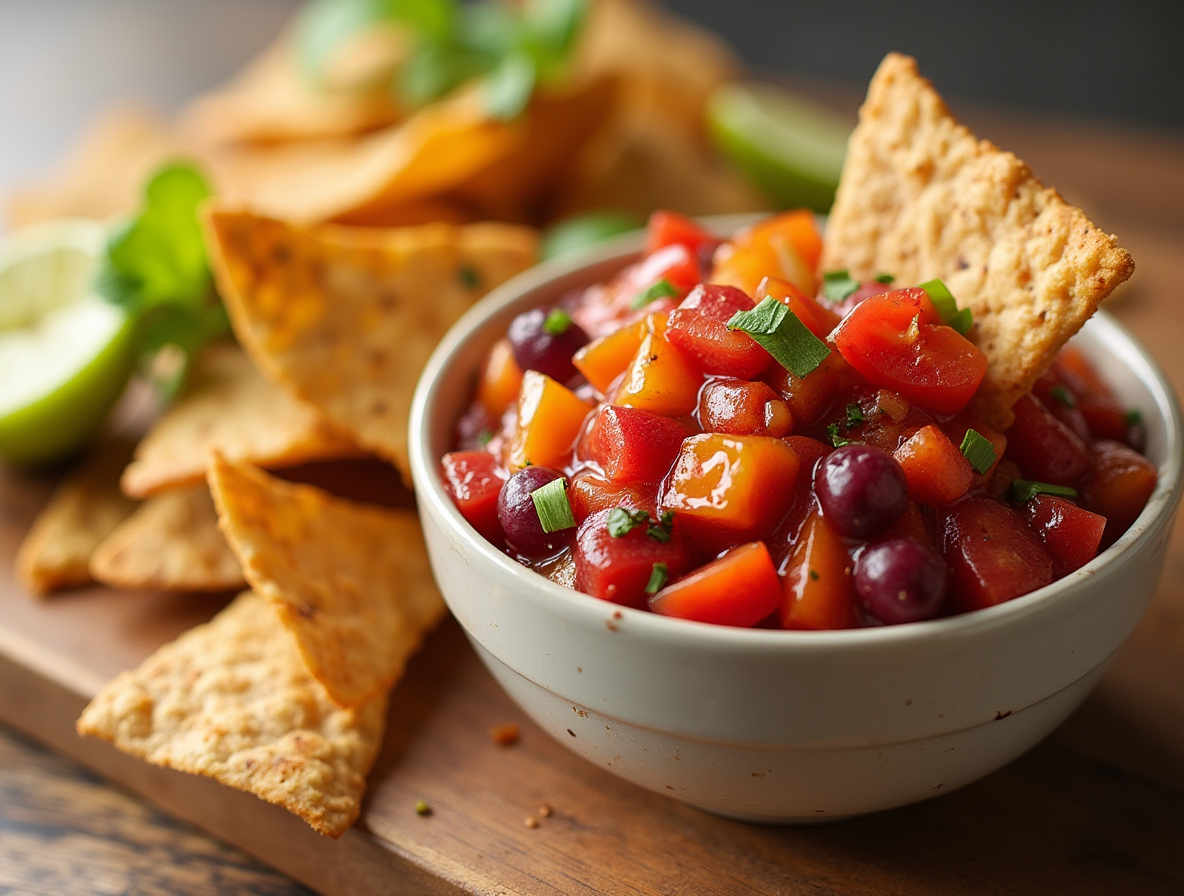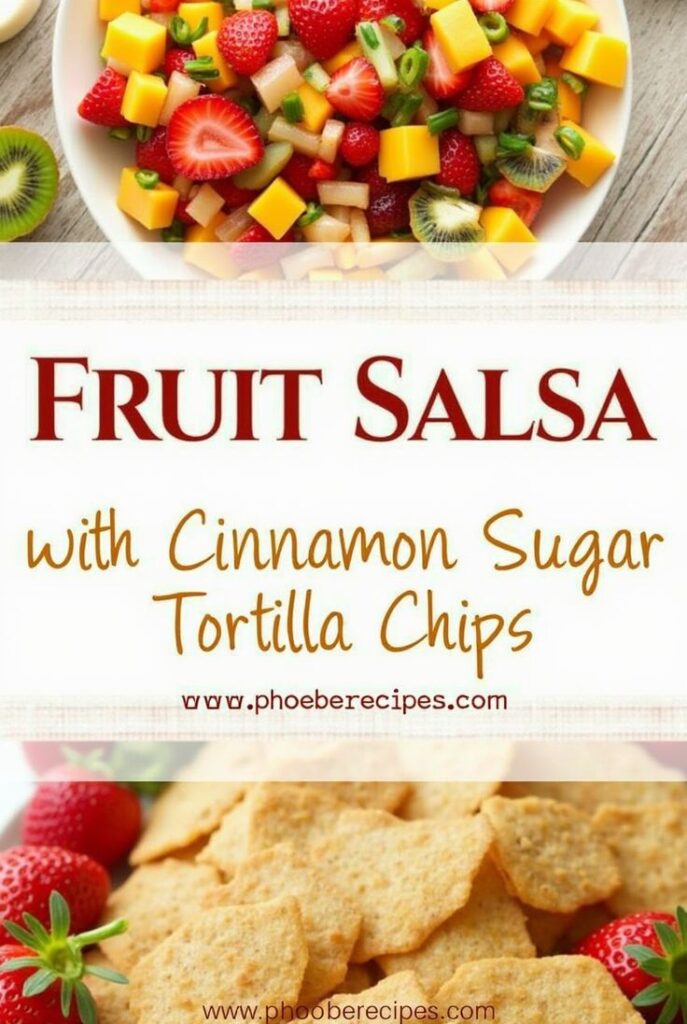The Perfect Fruit Salsa Recipe: Secret Tips for Crispy Cinnamon Chips (2025 Guide)
Fruit salsa recipes are certainly party favorites, often being the first dish to completely disappear from the table. I’ve witnessed this phenomenon countless times at gatherings, where guests can’t seem to get enough of this sweet twist on traditional salsa. Unlike its tomato-based cousin, fruit salsa combines strawberries, apples, raspberries, and other colorful fruits into a refreshing, versatile treat.
What makes fruit salsa with cinnamon chips so special is how easily you can customize it to your preferences. In fact, you can create your perfect fruit salsa recipe by mixing and matching kiwi, pineapple, mango, or oranges. Additionally, the crispy cinnamon chips made from flour tortillas provide the ideal vessel for scooping up this fruity goodness. Throughout this guide, I’ll share my best tips for creating the perfect fruit salsa and cinnamon chips recipe that will wow your guests and have them asking for more.
Choosing the Right Fruits for Your Salsa
The selection of fruits for your salsa can make or break the final dish. When crafting delicious fruit salsa recipes, understanding which fruits work best together—and which ones to avoid—will help you achieve that perfect balance of flavors and textures that keeps people coming back for more.
Best fruits for flavor and texture
The ideal fruits for fruit salsa have a texture similar to tomatoes in traditional salsa—soft and juicy but firm enough to hold their shape when diced. Fresh fruit generally works better than frozen, although you can use a combination for interesting textures.
Top performers for fruit salsa include:
- Strawberries and blueberries: Check the bottom of containers for bad berries
- Kiwi and mango: Offer sweet, fruity flavor with good structure
- Pineapple: Either fresh or canned (drained) works well
- Stone fruits: Peaches, nectarines, and plums provide juicy sweetness
- Melons: Watermelon and cantaloupe add refreshing juiciness
- Tropical options: Papaya and mango bring unique flavors
When summer fruits are abundant, take advantage of stone fruits and berries. During winter, consider citrus fruits or tropical options like pineapple that are available year-round.
Fruits to avoid and why
Not all fruits belong in your fruit salsa and cinnamon chips recipe. Several types can compromise your salsa’s texture and appearance:
Hard, crisp fruits like apples typically lack the juiciness needed for proper salsa consistency. Furthermore, extremely soft fruits such as bananas turn mushy quickly and deteriorate the overall texture.
Raspberries present another challenge—they’re too delicate and often break down completely. If you’re determined to use them, mix them with sturdier fruits like mango to maintain structural integrity.
Likewise, avoid highly acidic fruits that might break down other ingredients. Cranberries and rhubarb are too sour for raw applications and require cooking to balance their flavors.
How to balance sweetness and acidity
Every great fruit salsa recipe with cinnamon chips needs balance between sweetness and acidity. Fresh lime or lemon juice provides brightness that cuts through sweetness and helps preserve color. For most fruit combinations, half a lime usually suffices, though berry-based salsas might need more.
Before adding sweeteners, taste your fruits first. Ripe, in-season fruits often provide sufficient natural sweetness. However, if adjustment is needed, drizzle honey or sprinkle a bit of sugar to enhance flavors. Some fruit salsa and cinnamon chips recipes call for fruit preserves (like strawberry or apricot) to add sweetness and help bind ingredients.
Additionally, let your salsa rest in the refrigerator for at least 30 minutes before serving. This resting period allows flavors to meld and creates that perfect harmony between sweet and tangy notes.
Step-by-Step: Making the Perfect Fruit Salsa
Creating the perfect fruit salsa involves four simple steps that transform ordinary fruits into an extraordinary treat. While the process is straightforward, each step plays a crucial role in developing flavors and textures that make fruit salsa recipes truly shine.
1. Wash and prep your fruit
Start by washing your hands thoroughly with soap and hot water. Next, rinse all fruits under cool running water and drain them in a colander. This step removes dirt, pesticides, and potential bacteria.
For fruits like peaches and mangoes, peeling is essential as their skins can affect texture. Moreover, remove pits, cores, and stems as needed. A sharp knife makes this process safer and more efficient—precise cuts actually help your fruit last longer as a dull knife damages fruit in ways that speed decomposition.
2. Chop for scoopability
The secret to perfect fruit salsa texture is in the cutting technique. Dice all fruits into small, uniform pieces—think the size of traditional pico de gallo. This consistency ensures proper “scoopability” with your cinnamon chips and allows flavors to blend seamlessly.
Even berries benefit from careful cutting rather than being added whole. For jalapeños (if using), chop them slightly smaller than other ingredients to avoid overwhelming bites of heat.
3. Add sweeteners and citrus
Once your fruit is prepared, it’s time to enhance flavors. Combine the chopped fruits in a large bowl, then add your preferred sweetener. Options include fruit preserves, white sugar, brown sugar, or honey.
Subsequently, add freshly squeezed lime or lemon juice—this brightens flavors and prevents browning in fruits like apples. For extra dimension, consider adding a small amount of chopped herbs like cilantro or mint.
4. Let it rest for flavor blending
Following assembly, cover your fruit salsa and refrigerate it for at least 15-30 minutes before serving. During this time, something magical happens—flavors meld together as the sweeteners and citrus work through the mixture.
Nevertheless, remember that fruit salsa is best enjoyed within a few hours of preparation, particularly for watery fruits that release juice over time.
How to Make Crispy Cinnamon Chips
No fruit salsa recipe is complete without its perfect companion – crispy, sweet cinnamon chips. These delightful treats are surprisingly simple to make at home with just a few ingredients and proper technique.
1. Choosing the right tortillas
Flour tortillas consistently deliver the best results for cinnamon chips. Specifically, 8-inch taco-sized tortillas are ideal for cutting into manageable wedges. While corn tortillas can work, they’re more delicate and cook faster. Consequently, you’ll need to reduce baking time if using corn tortillas. Whole wheat tortillas offer a healthier alternative, yet traditional white flour tortillas provide superior flavor.
2. Butter vs. spray: what works best
Both butter and cooking spray create delicious cinnamon chips, yet each offers different benefits. Melted butter provides richer flavor and helps the cinnamon sugar mixture adhere better. Unsalted butter is preferable as salted butter can compete with the sweet flavors. Alternatively, butter-flavored cooking spray offers a lighter option with fewer calories.
3. Cinnamon sugar ratio
The perfect cinnamon-to-sugar ratio is consistently 1:4 across multiple sources. For practical measurements, use:
- 1 cup sugar with ¼ cup cinnamon
- ½ cup sugar with 2 tablespoons cinnamon
- ¼ cup sugar with 1 tablespoon cinnamon
This balanced ratio delivers ideal sweetness without overwhelming spiciness.
4. Baking time and temperature
Preheat your oven to 350°F (175°C), which is the standard temperature for most recipes. Place tortilla wedges in a single layer on a baking sheet, ensuring they don’t overlap. Bake for 8-10 minutes or until edges become golden brown and crispy. Essentially, keep a close eye on them as they can quickly burn due to the sugar content.
5. Cooling for maximum crunch
Once removed from the oven, immediately loosen the chips from the baking sheet to prevent sticking. Allow them to cool completely on a rack, as this crucial step is when they develop their maximum crunchiness. Store leftovers in a brown paper bag to maintain crispness for 3-5 days.
Tips, Variations, and Storage
The versatility of fruit salsa extends far beyond its basic recipe, making it a perfect canvas for creativity in the kitchen. First and foremost, understanding how to modify, store, and serve this crowd-pleaser will elevate your culinary repertoire.
Fruit salsa recipe variations
Beyond the classic recipe, fruit salsa can be reimagined in numerous exciting ways. For a Mexican-inspired twist, combine your fruit base with finely diced white onion, minced jalapeño (seeds removed), a squeeze of lime juice, and a sprinkle of Tajin chili lime seasoning. In contrast, tropical fruit salsa shines when made with mango, pineapple, and papaya instead of apples, peaches, and strawberries. Fruit pico de gallo offers yet another variation, incorporating traditional pico ingredients like tomatoes and onions for a unique flavor profile.
Store-bought vs. homemade chips
Obviously, homemade cinnamon chips deliver superior flavor and freshness, as they contain no corn syrup and use simple ingredients. In a pinch, store-bought alternatives work well—cinnamon graham crackers, cinnamon pita chips from brands like Stacey’s, or Siete’s grain-free options provide convenient solutions. Many guests won’t notice the difference, especially when focusing on your amazing fruit salsa!
How to store fruit salsa and chips
Fruit salsa is best enjoyed within 24 hours of preparation, as fruits release juices over time. For optimal results, store leftover salsa in an airtight container in the refrigerator for up to 3-5 days. To prevent sogginess, some recommend storing it in a salad spinner or colander fitted in a bowl to keep fruit above accumulated juices. Homemade cinnamon chips remain crispy when stored in an airtight container at room temperature for 3-5 days or in a brown paper bag to maintain crispness.
Creative serving ideas
Aside from the traditional pairing with cinnamon chips, fruit salsa shines in numerous applications. Try spooning it over vanilla ice cream for a refreshing dessert, or use it as a topping for angel food cake. The sweet-tangy profile complements savory dishes beautifully—serve it alongside grilled chicken, fish tacos, or beef barbacoa for a refreshing contrast. For brunch gatherings, consider offering it as a topping for waffles or pancakes with a dollop of whipped cream.
Conclusion
Fruit salsa with cinnamon chips certainly stands as one of the most versatile and crowd-pleasing dishes you can bring to any gathering. Throughout this guide, we’ve explored everything from selecting the perfect fruits to creating those irresistibly crispy cinnamon chips.
The beauty of this recipe lies in its adaptability. You can customize it based on seasonal availability, personal preferences, or dietary needs. Though simple to prepare, the attention to detail makes all the difference – uniform fruit pieces for perfect scoopability, the ideal 1:4 cinnamon-to-sugar ratio, and allowing time for flavors to meld properly.
My experience has shown that homemade always trumps store-bought alternatives, especially when it comes to the cinnamon chips. Nevertheless, quality pre-made options work well when you’re short on time.
Remember that timing matters with fruit salsa. Prepare it within a day of serving for optimal freshness and texture. Similarly, allow your chips to cool completely for that satisfying crunch everyone loves.
Last but not least, don’t limit yourself to traditional serving methods. This versatile dish works wonderfully beyond chips – try it over ice cream, alongside grilled meats, or atop breakfast favorites. Your creativity can transform this simple recipe into countless memorable dishes that friends and family will request time and again.
Now that you have all these secrets and tips, your fruit salsa with cinnamon chips will undoubtedly become the star of your next gathering. Happy cooking!
FAQs
Q1. What are the best fruits to use in fruit salsa? The best fruits for fruit salsa include strawberries, blueberries, kiwi, mango, pineapple, and stone fruits like peaches and nectarines. These fruits offer a good balance of sweetness and texture, holding their shape well when diced.
Q2. How do you make cinnamon chips crispy? To make crispy cinnamon chips, use flour tortillas, brush them with melted butter or cooking spray, sprinkle with a 1:4 cinnamon-to-sugar ratio, bake at 350°F for 8-10 minutes, and allow them to cool completely on a rack for maximum crunchiness.
Q3. Can fruit salsa be made ahead of time? While fruit salsa is best enjoyed within 24 hours of preparation, you can store it in an airtight container in the refrigerator for up to 3-5 days. To maintain freshness, consider storing it in a salad spinner or colander fitted in a bowl to keep the fruit above accumulated juices.
Q4. What are some creative ways to serve fruit salsa? Besides serving with cinnamon chips, you can use fruit salsa as a topping for ice cream, angel food cake, waffles, or pancakes. It also pairs well with savory dishes like grilled chicken, fish tacos, or beef barbacoa for a refreshing contrast.
Q5. How long do homemade cinnamon chips stay fresh? Homemade cinnamon chips can stay crispy for 3-5 days when stored in an airtight container at room temperature. Alternatively, you can store them in a brown paper bag to maintain their crispness.


